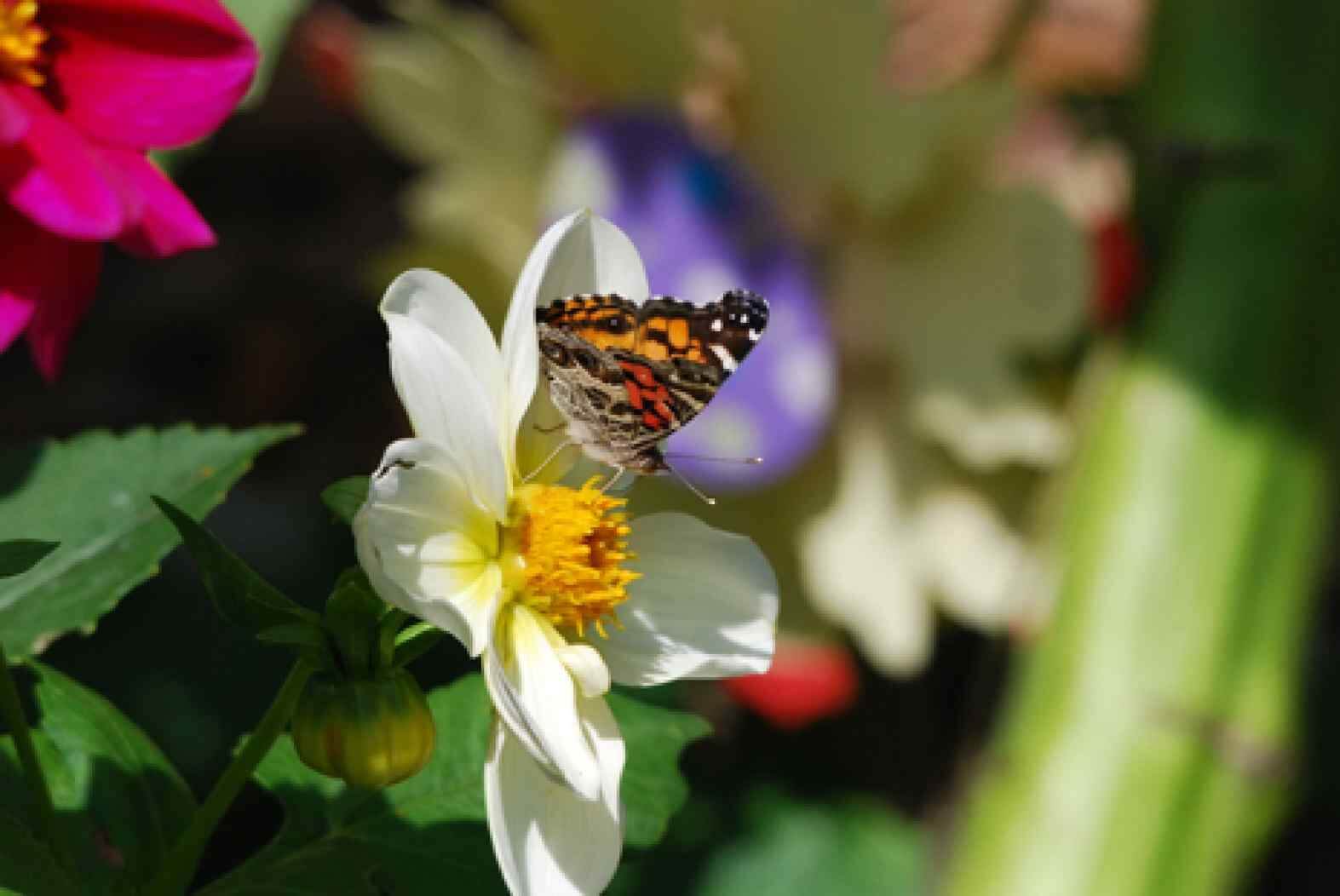There are three closely related ‘Ladies’ that are easy to provide for in a habitat garden; the Painted Lady, the American Lady, and the West Coast Lady; however, they are not always easy to tell apart. Personally, I’m happy to see any and all of the butterflies coming to my garden for resources, and when I notice a medium-sized orangey butterfly I can be pretty sure it is one of the ‘ladies’. They often don’t sit still long enough, or with their wings held just so, to easily identify the characteristic field marks.
Field Guides
A really good start to learning to identify butterflies in the field and garden is to get out into the field with a good naturalist. In some areas people organize a 4th of July butterfly count – much like birders who do a Christmas count; getting involved with a group like that can be a rich education.
Getting a good guide to butterflies is also very helpful, and you can start to educate yourself before going into the field by studying the different families of butterflies. There are only five major families found in the western states; learning the distinctive colorations, wing shapes, sizes, and different behaviors of the butterflies within each of the families is a really good start. Identification in the field is also simplified by paying attention to; your specific location, and the time of year, the plant community, or habitat you are in, and whether the butterfly you are observing is associating with a particular plant.
Three books I turn to all the time are:
Common Butterflies of California, by Bob Stewart;
Bob is an amazing naturalist and wonderful to accompany in the field. I try to go on a least one hike a year with Bob when he comes to Marin County. Bob has a vast store of knowledge, from geology to insects and birds, and all the plants associated with these creatures in various communities and habitats.
But, his favorite things are the ‘belly flowers’; the observer has to be on the ground, prone on their belly, to really see the details and the hidden beauty of these tiny flowering plants. Bob likes to say; “When you see the small things, you see everything.”
You may have noticed that Bob is also an accomplished photographer; he took all the photos in his book, and generously allows me to use some of his photos to illustrate this website.
Butterflies through Binoculars ‘The West’ by Jeffrey Glassberg;
A very comprehensive guide to butterflies in the western states, this guide has lots of small photos arranged to help compare and contrast butterflies that are similar; for example all three ‘ladies’ are shown on the same page. This guide also shows subspecies, and the difference between male and female butterflies when there are distinguishing marks.
Caterpillars in the Field and Garden by Thomas J. Allen, Jim P. Brock, and Jeffrey Glassberg;
Butterfliers waited a long time for this book! It is important to be able to ID the different life stages, and this book makes it so much easier.
Once you’ve spent some time observing butterflies, in the wild or in your garden; you will develop a certain ‘gestalt’ about familiar butterflies and can make some quick determinations as to the family group or species by knowing:
- the plant community and habitat the different species are most likely to be seen in –
- the terrain you are looking at – trails and dirt roads, hilltops, or canyons and gullies –
- the general size and coloration of the species –
- the flight patterns and the time of year the adults are flying –
- specific behaviors – such as hilltopping or puddling –
- the plants, or other materials the adults are feeding at –
- the larval host plants in the area
I like to think of butterflies, and the whole fascinating array of invertebrates as ‘miniature wildlife’; every bit as interesting and diverse as the impressive animals of the African savannah. Insects are everywhere, and they create the very foundation of all other life. Even we humans are dependent on insects: because our food supplies would diminish without the pollinators – and our garbage would really pile up without the decomposers!
Urban Habitats
Even the smallest garden can become a habitat full of life; you just might need a magnifying lense to really appreciate all the details. Urban gardens also allow the gardener to include a greater range of plants, since there is no worry about weedy species or certain invasives spreading into adjacent wildlands. Some introduced weeds, common food crops, and old-fashioned flowers are really great habitat plants; the following butterfly species all associate with these types of plants.
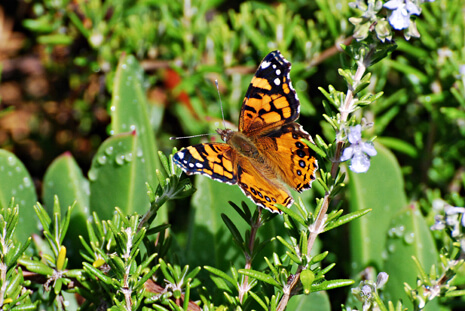
West Coast Lady on Rosemary
West Coast Lady – Vanessa annabella
This is another of the ‘Brushfoot’ butterflies, and it associates mostly with plants in the Mallow family.
The larvae look similar to the larvae of the Painted Ladies’; their dark bodies have little tufts and spines, and a pattern of goldish dashes and spots. These larvae also create little protective nests to feed from by rolling up leaves of the host plants.
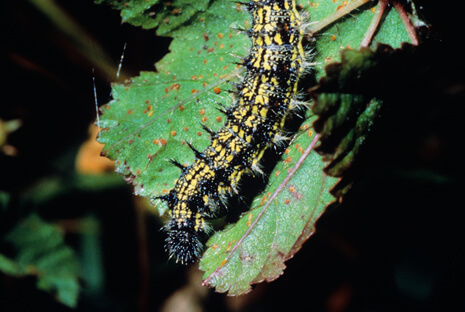
Larva of the West Coast Lady feeding on a mallow family plant, photo by Bob Stewart
The males of this species (if you’re lucky enough to have a sizeable population in your area) are very territorial in the late afternoon. They will assume a perch, often one which also offers good basking opportunities, and will attempt to chase off other males, and mate with females entering this territory. The male butterfly returns to the same perch after each foray. These territories are not permanent; each day the best ones are reallocated to the earliest arriving individuals.

The underwing of the West Coast Lady showing the beautiful ‘paint box’ colors Photo by Bob Stewart
West Coast Lady populations move up and downslope seasonally in the mountains where they can be seen in all types of habitats except dense, dark forest. However, this butterfly is somewhat scarce in the open spaces; it is now most commonly seen in urban areas, vacant lots in cities, and weedy agricultural farmlands.
And that has a lot to do with the preferred larval host plants of this species. Many common garden plants such as Hollyhocks, Sidalceas, and Lavatera can be food for the caterpillars. Common weeds in the mallow family like the Cheeseweeds (Malva neglecta. M. nicaeensis. and M. parviflora) are often host plants.
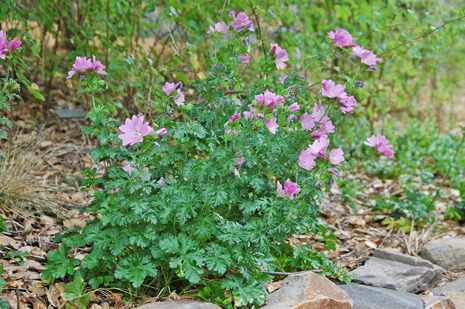
Sidalcea ‘Party Girl’ a garden hybrid that attracts several different species of butterflies
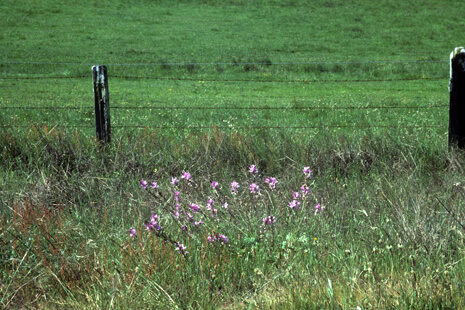
Sidalcea malviflora growing in a grassland
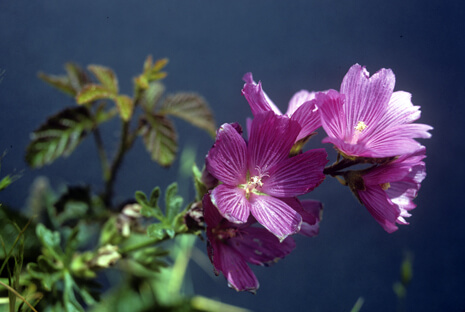
Close-up of the Sidalcea flower
West Coast Ladies also use California native mallows like Checkerbloom, Sidalcea malviflora; a perennial wildflower which usually grows in the grasslands. I like to incorporate Checkerbloom in my garden beds, usually in a mingled planting with bunch grasses.
I also grow Mission Mallow, Malva (Lavatera) assurgentiflora, in my garden. I’ve never seen larvae feeding on this plant, but one can always hope; and meanwhile the hummingbirds appreciate the blooms, and lots of creatures eat the ripe seeds. The specific botanical name refers to the fact that the flowers start opening, one by one, lower down on the main stems, and proceed to open ascending up the plant. Sometimes this plant will host a population of aphids; and then I’ve watched as a whole flock of Bushtits – usually about 18 or more individuals – come in to carefully glean the insects off the plant.
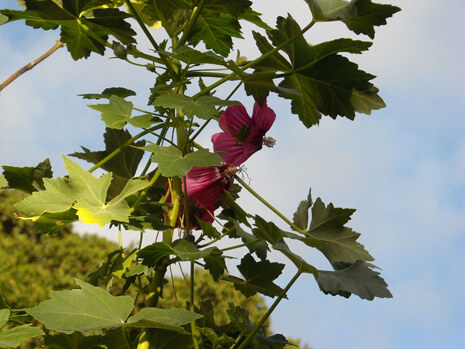
Malva (Lavatera) assurgentiflora
Mission Mallow grows very fast; so fast that I usually start it from seed (fresh seed germinates most readily) and can count on a six-foot shrub within a year. The plant makes an impressive specimen in a sunny border, or in a large container; and, since it adapts to regular pruning, it can be used as a hedging plant. But only if your garden is fenced off from the deer; they do love to eat this plant!
The West Coast Lady will occasionally use a member of the nettle family called Sticky Weed or Pellitory (Parietaria judaica) as a larval host plant. So does the closely related Red Admiral. I allow this weedy plant to grow in drifts in odd shady corners of my garden; it will even grow underneath the decks. It’s easy enough to keep it under control; and I keep hoping to find larvae on it!
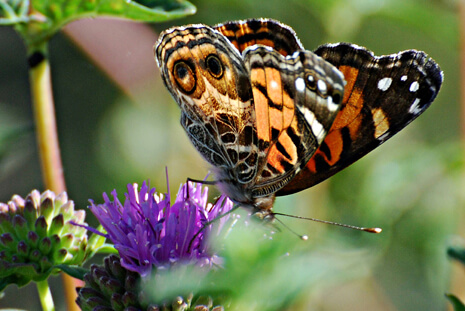
American Lady on Monardella
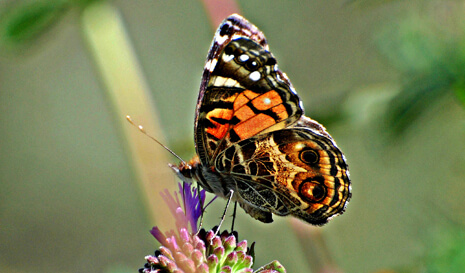
Underwing of the American Lady
American Lady – Vanessa virginiensisThis ‘Lady’ is listed in most books as the least common of the ‘Ladies’; but in my garden I see it frequently, especially in summer. It’s a butterfly of the grasslands and woodland edges, and because it associates with weedy plants, it also frequents urban areas. The two very large eyespots on the hind wing make it fairly easy to ID in the field; if I see it basking with wings spread open I also look for the tiny white dot within an orange cell on the front wing.
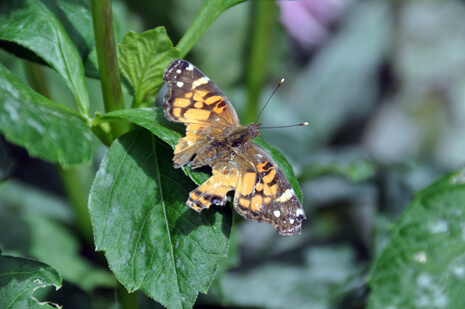
Very tattered American Lady
Sometimes it’s nearly impossible to see the field marks: some or all can be missing because of bird bites. In this specimen you can’t see the eyespots on the hind wings, though the birds probably did – and aimed for just that – leaving the body in tact! And that is the whole point of the eyespots: they are there to help fool the visual predators. Butterflies can still fly with up to two-thirds of their wings missing!
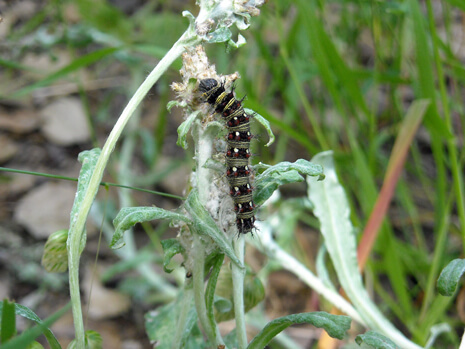
Late instar American Lady larva feeding on Cudweed
But, in my garden, what I’m really looking for are the larvae. They are the most beautiful larvae of this group; hairs and spines cover a dark body which is banded black and white and red with bold white dots in between. These are warning colorations to protect against visual predators, and the hairs and spines provide some protection against parasatoids; and yet, in addition, the larvae hide during the day in nests they create from plant materials. That’s a lot of defensive strategy!
The larvae feed on several members of the ‘Cudweed Tribe’, within the Aster family. One member of this tribe is an attractive native perennial wildflower that I grow in my planted borders and in sunny spots within my woodland. Pearly Everlasting (Anaphalis margaritaceae) is a clump forming perennial with greenish to white wooly leaves and clusters of cute little yellowish-white ‘straw flowers’. The plant blends nicely amongst other perennials and grasses and can grow in part to full sun. The foliage has a distinctive odor, a bit like a curry blend; when we’re out hiking on a warm day, I often smell this plant before I see it!
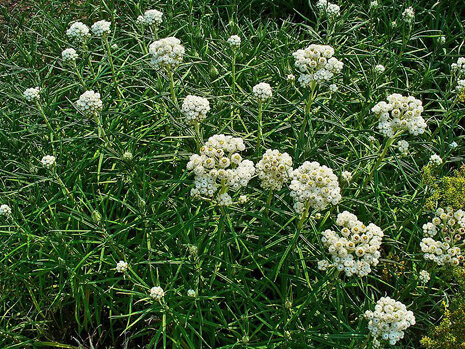
Pearly Everlasting (Anaphalis margaritaceae)
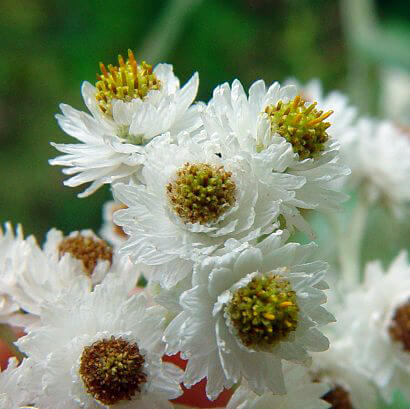
Close-up of the flowers of Pearly Everlasting
But the larval host plant the American Ladies seem to prefer, and least in my experience here in Marin, is a weed; and I let controlled patches of this ‘Cudweed’ grow all over my property. Gnaphalium luteo-album is a common weed introduced from Eurasia, which now grows in dry areas along roads and trails and amongst grasslands all over the west. In my garden I let little patches grow where they seed themselves in; often at the edges of my gravel pathways, around stepping stones, and sometimes with containers or planting beds.
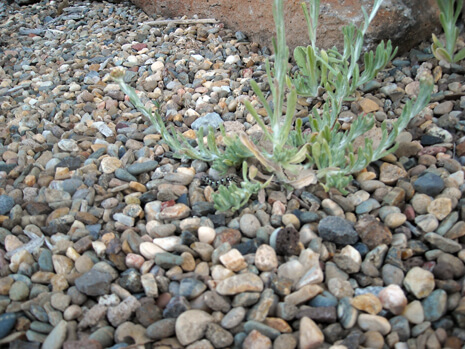
Cudweed – Gnaphalium luteo-album – growing in my pathway – look closely to see the larva!
The adult female lays her eggs on the fresher leaves of the plant; the larvae feed on these, but they make their nests closer to the flower, webbing up the plants and incorporating dry flower parts into a rather messy nest. Soon the nest fills with their frass; then they move on and build another nest. In the mornings and at dusk the larvae will venture out of the nest to feed; they are bolder the larger they get, so sometimes I’ve seen them feeding out in the open, in the middle of the day.
Two other Cudweeds, both California natives, grow in my garden and in clearings in the woodland. Purple Cudweed (Gnaphalium purpureum) is a small gray-leafed plant with a purplish inflorescense. It grows in compacted soil along pathways and in part shade under the oaks. I’ve never found any larvae on it.
I first saw Gnaphalium californicum growing on hot dry ridge not far from my house; and then I saw it seeded into an area in a neighbor’s garden. She wondered what the plant was, but did not want to keep it, so I transplanted a few seedlings to my garden. It is a perennial plant, and I am encouraging it to form a colony in one of the wilder areas on my property; but I have yet to find larvae feeding on it.


